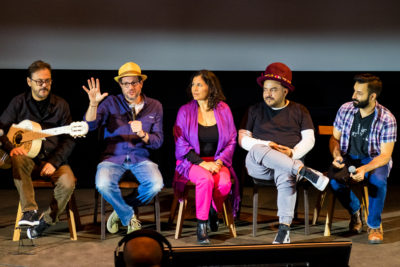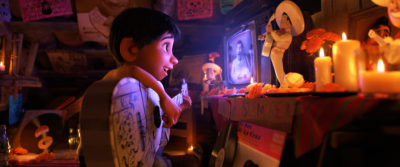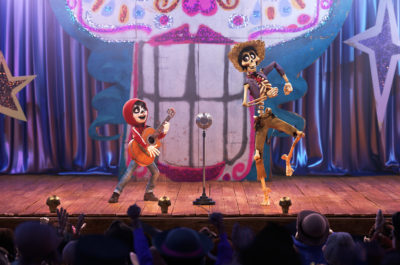The Music of Pixar’s First Musical, “Coco”
 Much of the hype surrounding Pixar’s Coco has been around the fact that it’s the studio’s first animated musical. While Pixar films have been using music to support their stories since the first Toy Story, audiences aren’t used to seeing Pixar characters burst into song. “More so than any other film we’ve made at Pixar, music has been such a crucial part of the storytelling and the story development process,” explains Co-Director Adrian Molina.
Much of the hype surrounding Pixar’s Coco has been around the fact that it’s the studio’s first animated musical. While Pixar films have been using music to support their stories since the first Toy Story, audiences aren’t used to seeing Pixar characters burst into song. “More so than any other film we’ve made at Pixar, music has been such a crucial part of the storytelling and the story development process,” explains Co-Director Adrian Molina.
“To create the music of Coco, we found that there were three types of music that we needed to talk about and the first was source music. Miguel lives in this town of Santa Cecilia where this great musician Ernesto de la Cruz came from and as such, all of these musicians who were inspired by this guy come and they play in this plaza. We really wanted the world that Miguel lives in to be inspiring to him and to be full of music. And as such, we wanted to lean very much into Mexican music, the broad tapestry of Mexican music and the diversity therein. This is music that is traditional, is played in the context of the world and that inspires Miguel through his journey.”
Camilo Lara was brought on board during pre-production as the Music Consultant to help define the musical style of Coco. “The main goal was to create this universe as if it was music on the streets in Mexico in a town like Santa Cecilia. So it was a big challenge because the landscape in a town, in a plaza, you keep hearing nonstop music and all types of music. So we went from a wide range of genres like trio to mariachi to banda and danzón and we did some sessions in Mexico with some really amazing, really talented musicians and I think you can hear it. The whole idea was to have a sonic landscape that smells like Mexico. That was the main goal.”
Another member of the music team, Germaine Franco, brought in some traditional Mexican songs and musicians to help make the world feel more alive. “We decided in terms of tunes that we would record, we had three different categories. We had traditional songs that you would hear throughout Mexico if you were growing up, for example ‘Cielito Lindo’ is a song that most Americans know so we did not particularly record that one because it’s used in a lot of films, but we did decide on some songs that are specific to oaxaca, like ‘La Sandunga.’ Throughout Mexico, everyone knows it. ‘La Llorona’ as well, ‘La Fontanella,’ and also we did ‘La Paloma’ and we also recorded some source music that Michael Giacchino wrote in the style of Mexican genres.”

“The second type of music that we knew we needed to talk about of course is score,” Molina continues. “How were we going to create themes for these characters and these conflicts and these settings that support the storytelling, that support the emotion, that support the drive?” The answer to those questions came from Michael Giacchino, composing his sixth Pixar animated feature with Coco.
“I came onto this project fairly early on because we were talking about doing source music and different things for the film,” Giacchino recalls. “But as far as the score goes, generally when I come onto a film I like to watch the film, I don’t want to read a script necessarily because it puts different images in my head than what the directors will eventually have. So I wait until I can see a version of the film and when I watched this film, it made me very emotional. I loved what the film was saying and I loved what the film was about. My first exposure to Mexican music was as a kid, my dad had this crazy record collection with everything from Mancini to Leo Rota to crazy Russian music and there was this one album in there like ‘The Music of Mexico.’ And I remember as a kid down in the basement, I would listen to that album over and over and over. I was struck by how melodic it was and I could remember all of these melodies. For me it was all about ensembles playing together and I loved the sounds. So watching this movie instantly took me back to my childhood as a kid.”
For most composers, music is primarily conducted on a piano. But since Coco features a variety of musical styles and emotional beats, he decided to compose them on a guitar and then make sure they could also be played by a full orchestra. On this same point, Molina adds, “As filmmakers, Lee [Unkrich] and I knew that in Coco, there are a lot of moments that we wanted to use the music of the world to characterize somber moments or festive moments or really rowdy moments and doing that in a way that really tapped into the sounds of Mexico.”
The third and final type of music that Adrian Molina knew the story would need is original songs. “The first one that we have in the film is the incredible ‘Remember Me’ written by Kristin Anderson-Lopez and Robert Lopez, they’re extremely talented and extremely lovely to work with and ‘Remember Me’ has so much riding on its shoulders because it’s establishing this character of Ernesto De la Cruz. We wanted to tap into this feeling of a kind of glamorous golden age of Mexican cinema character who’s larger than life and ‘Remember Me,’ with the help of Germaine arranging it in this style that felt of the time and of the scope of a star like Ernesto de la Cruz, really kicks off the film in a wonderful way.”
 “’Remember Me’ is an iconic song and it’s a song that has many messages,” Germaine Franco adds. “The theme that runs throughout is people remembering their loved ones and that how when they’ve past, their memories are kept alive. This song is quite beautiful when played in different settings.”
“’Remember Me’ is an iconic song and it’s a song that has many messages,” Germaine Franco adds. “The theme that runs throughout is people remembering their loved ones and that how when they’ve past, their memories are kept alive. This song is quite beautiful when played in different settings.”
Germaine Franco and Adrian Molina collaborated as songwriters on five additional songs featured in the film, one of which, “Much Needed Advice,” features short snippets of multiple songs by Ernesto de la Cruz and original score by Michael Giacchino, a perfect blending of all three talents. Once you see Coco, the story and songs will never leave you thanks to the hard work and extraordinary talent of all of the artists at Pixar Animation Studios.
Pixar's Coco is now playing in theaters. All of the music discussed in this article is also available on the Original Motion Picture Soundtrack, available wherever music is sold.




